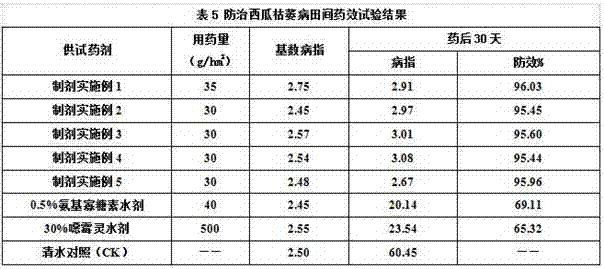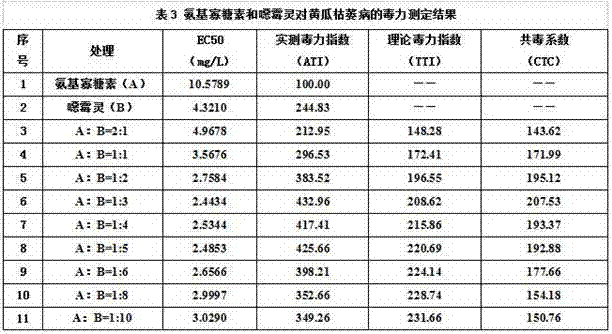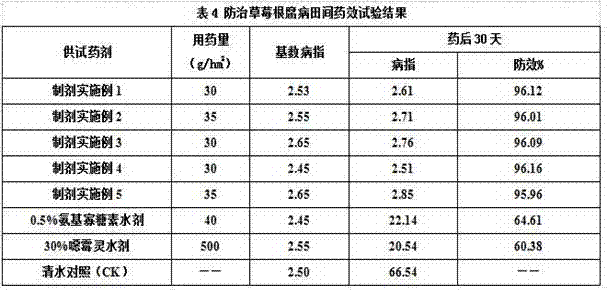Granule bactericidal composition containing amino-oligosaccharin and hymexazol
A technology of amino oligosaccharide and composition, which is applied in the field of pesticides and achieves the effects of saving labor cost, reducing usage amount, and obvious control effect
- Summary
- Abstract
- Description
- Claims
- Application Information
AI Technical Summary
Problems solved by technology
Method used
Image
Examples
Embodiment 1
[0021] Toxicity Measurement Example 1 Indoor Toxicity Measurement to Strawberry Root Rot
[0022] Test object: Strawberry root rot
[0023] Test method: refer to the standard method of bioassay NY / T 1156.2-2006, using the medium method containing medicine: take 3mL of the medicine solution with a series concentration of each single agent and mixed agent, add it to 27mL PDA medium cooled to 45°C, and prepare Prepare the drug-containing medium plate at the desired final concentration. Then, a 6mm-diameter hyphae piece was prepared from the edge of the pathogen colony cultured for 7 days, and moved to each series of drug-containing medium, with the hyphae facing down, and each treatment was repeated 4 times. After the treatment, culture in a constant temperature biochemical incubator at 25°C, measure the colony diameter after 4 days, and calculate the growth inhibition rate. Through the linear regression analysis between the probability value of the inhibition rate and the loga...
Embodiment 2
[0031] Virulence Determination Example 2 Indoor Toxicity Determination of Watermelon Fusarium Wilt
[0032] Test object: Fusarium wilt of watermelon
[0033] Test method: refer to the standard method of bioassay NY / T 1156.2-2006, using the medium method containing medicine: take 3mL of the medicine solution with a series concentration of each single agent and mixed agent, add it to 27mL PDA medium cooled to 45°C, and prepare Prepare the drug-containing medium plate at the desired final concentration. Then, a 6mm-diameter hyphae piece was prepared from the edge of the pathogen colony cultured for 7 days, and moved to each series of drug-containing medium, with the hyphae facing down, and each treatment was repeated 4 times. After the treatment, culture in a constant temperature biochemical incubator at 25°C, measure the colony diameter after 4 days, and calculate the growth inhibition rate. Through the linear regression analysis between the probability value of the inhibition...
Embodiment 3
[0041] Virulence Determination Example 3 Indoor Toxicity Determination of Cucumber Fusarium Wilt
[0042] Test subject: Cucumber Fusarium wilt
[0043] Test method: refer to the standard method of bioassay NY / T 1156.2-2006, using the medium method containing medicine: take 3mL of the medicine solution with a series concentration of each single agent and mixed agent, add it to 27mL PDA medium cooled to 45°C, and prepare Prepare the drug-containing medium plate at the desired final concentration. Then, a 6mm-diameter hyphae piece was prepared from the edge of the pathogen colony cultured for 7 days, and moved to each series of drug-containing medium, with the hyphae facing down, and each treatment was repeated 4 times. After the treatment, culture in a constant temperature biochemical incubator at 25°C, measure the colony diameter after 4 days, and calculate the growth inhibition rate. Through the linear regression analysis between the probability value of the inhibition rate ...
PUM
 Login to View More
Login to View More Abstract
Description
Claims
Application Information
 Login to View More
Login to View More - R&D
- Intellectual Property
- Life Sciences
- Materials
- Tech Scout
- Unparalleled Data Quality
- Higher Quality Content
- 60% Fewer Hallucinations
Browse by: Latest US Patents, China's latest patents, Technical Efficacy Thesaurus, Application Domain, Technology Topic, Popular Technical Reports.
© 2025 PatSnap. All rights reserved.Legal|Privacy policy|Modern Slavery Act Transparency Statement|Sitemap|About US| Contact US: help@patsnap.com



